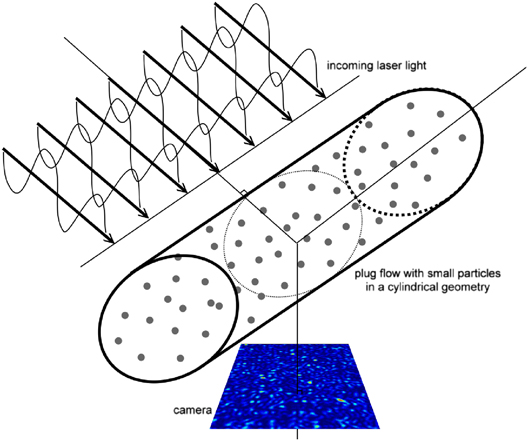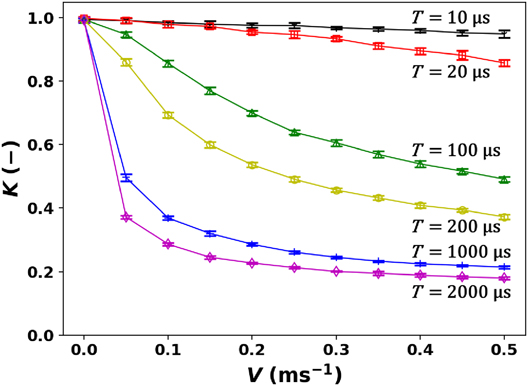Kevin van As, Bram A. Simons, Chris R. Kleijn, Sasa Kenjeres, Nandini Bhattacharya. The dependence of speckle contrast on velocity: a numerical study[J]. Journal of the European Optical Society-Rapid Publications, 2022, 18(2): 2022010
Search by keywords or author
Journals >Journal of the European Optical Society-Rapid Publications >Volume 18 >Issue 2 >Page 2022010 > Article
- Journal of the European Optical Society-Rapid Publications
- Vol. 18, Issue 2, 2022010 (2022)

Fig. 1. Simulation setup: a plane wave is incident on a cylindrical geometry filled with tiny spherical particles in motion. A “camera”, placed at a right angle, measures the resulting dynamic interferometric speckle pattern over time. Figure not to scale.

Fig. 2. Speckle contrast K dependence on scatterer velocity V for various camera integration times T. The error bars show the spread (standard deviation) caused by 10 different sets of random initial particle positions.
Fig. 3. Speckle contrast K dependence on scatterer “distance travelled”, d = VT. The data points are from Figure 2 , and are shown to collapse onto a single master curve.
Fig. 4. Speckle contrast versus (τc/T)/w = d−1. The data points are the same as in Figure 3 . The values of w and β of models (2) –(4) are fit (exception: in the Lorentzian model β = 1 is used), using only the data points with d−1 ≥ 3 × 104.
Fig. 5. Speckle contrast versus (τc/T)/w = d−1. The data points are the same as in Figure 3 . The value of w of models (2) –(4) are fit, using only the data points with d−1 ≥ 3 × 104, and β = 1 is taken.
| ||||||||||||||||||||
Table 1. Used fit parameters of models (2) –(4) .

Set citation alerts for the article
Please enter your email address



